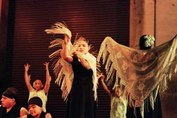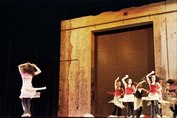|
 |
|
|
 |
 |
The Kidpresented by the Henry Street Settlement Abrons Arts Center Dance Program Review by Robert Abrams
See Lisa Allen's Photos below
June 1, 2003 There is a continuum of dance styles that starts with classical ballet (ABT), moves on to contemporary ballet (NYCB), pauses on a reef somewhere in between ballet and modern dance (Paul Taylor), moves on to modern dance (Martha Graham and The Joyce), and ends at post-modern dance, otherwise known as "downtown" dance (Danspace Project). This afternoon I discovered that the future of dance lies even further downtown, at the Henry Street Settlement Abrons Arts Center Dance Program. Under the direction of Daniel Catanach, a multitude of kids and a few dance faculty delivered an impressive performance that was well crafted to the needs of its performers and its audience. I enjoyed the show too, even though I was not related to any of the performers. I had a chance to talk to about eight of the students before the performance. It is clear from their comments that the Abrons Arts Center Dance Program has had an important and sustained impact on their lives. Many started taking dance lessons at the Center at an early age. Nearly all of the students I talked to acted on their teachers' encouragement to expand their study to new styles of dance. For instance, one student started in Salsa. When his teacher encouraged him to try jazz and ballet, he did and discovered that he liked those dances too. Students have studied Salsa, Flamenco, Jazz, Ballet, Mexican Folklore dances, and Tap dance. Several students explained that they have been taught more than dance. One student explained that she especially liked the Salsa piece in "The Kid" because you get the feeling of the culture, and that you can get the feeling of the culture even if you don't understand the words being sung. The students I talked to came from Brooklyn, the Bronx and from around the corner in the Lower East Side of Manhattan. It takes a little extra effort to get to the Lower East Side from The Grid (aka, Manhattan north of 14th street), so if students are voluntarily coming from the Bronx to study dance at the Center, you know they value the experience. Their teachers have taught them not to be afraid, and not to fool around. One eight year old student commented that she started dancing Flamenco because she thought the costumes were beautiful. After she got into the classes, she realized that dance takes hard work. Clearly she has taken that lesson to heart and put in the work. Students feel that the Center is like a family because they help each other. The students had nothing but praise for their teachers (Daniel Catanach, Yvonne Gutierrez and Randy Luna), even though Daniel told them to be honest. Their praise was backed with genuine feeling and many details about when they started studying each style of dance, so I have no reason to doubt they were speaking honestly. Some of the students I talked to hope to build on their experiences at the Center and become professional dancers. One student suggested that while she loves performing, she hopes to become a professional something else. The final student I talked to didn't know what she wants to do, but she is only about ten years old, so she is entitled to her uncertainty. I also spoke to Randy Luna, who used to be a student at the Center and now is on the Center's faculty. He has come back to the Center to give opportunities to the kids just like Danny (Catanach) gave him opportunities when he was a student. Randy likes that the dance program is cultured and diversified. The kids have a lot to offer and the dance program helps them develop their potential while keeping them off of the streets. Randy never thought he would be in Ballet, but once he tried it, he fell in love with it. Now he wants to become a choreographer. As I stated above, I thought that overall "The Kid" was very enjoyable and well performed as a show. Mr. Catanach and company had a much bigger challenge than just putting on a show, however. They needed to present students of varying abilities so that all of the students looked presentable, while presenting a show that stood on its own. They had to cater to each set of parents, while also presenting a show that would be valued in its entirety by all of them (plus the odd outsider like me). They needed a through-line that would tie the whole show together, while still allowing them to use the material available (namely, the styles of dance they have been teaching at the Center). They rose to this bigger challenge and succeeded. "The Kid" loosely tells the story of William H. Bonney (Billy the Kid), who grew up in what was then the Irish part of the Lower East Side of Manhattan. The first act is set in New York, with the second act set out West. While there are scenes that suggest a narrative, such as a family scene, or a scene with Billy interacting with street toughs, the narrative is more of a suggestion. Thus, "The Kid" is more of a contemporary ballet than a full story ballet. "The Kid" is also not strictly an historical drama either, but since the narrative served more as tone than text, strict historical accuracy was not necessary. This flexibility allowed the show to use dances being taught at the Center, such as Salsa and Flamenco to suggest the tone of Billy's life in New York without having to teach Irish dance styles to the kids. Far from bothering me, I thought the compression of the past and present Lower East Side worked rather well. The first act started with a classical ballet section by teachers Ocean and Randy. One can argue whether or not teachers should appear in a student show, but I thought it was a good choice. Their inclusion allowed the parents to experience all of the talents of the Center's dance program, both students and faculty. Besides, the students held their own, whether in sailor tap dance number, a flamenco number with shawls and skirt waving, or gymnastic break dancing. I especially liked the Salsa number that started with the Afro-Cuban style and then segued into modern Salsa. There was even an inventive passage where dancers were passed from one to another like a rueda or a birthday dance. Act II, set out West, started with what looked like a revival meeting. The choreography made good use of waves of dancers to show off the many talented kids. As Mr. Catanach commented after the show, he intentionally structured the show this way, rather than as a traditional recital where one student performs at a time, to make sure that the whole audience enjoyed the whole show (and not just their own kid's number), and to give the kids the challenge of doing a full show. The results clearly justified his decision to choreograph the show this way. The choreography also made use of repeating images. This was also a good choice. Dance, like speech, is a fleeting art. Some careful repetition can help the dance sink into the audience's appreciation of the work. The cowboy hip-hop number, set to Will Smith's version of Wild Wild West, had very bold and readable choreography. In one number, the students did the singing with clear voices. In the midst of many pure dance numbers, the audience got an idea of Billy the Kid's life, falling in with Western toughs, becoming an outlaw, getting in a shoot out, getting caught and on to his death. The show is tied together and brought to a close by Billy's depicted remembering of his mother, who appears as if in a dream. As Lisa Allen commented, who attended to photograph the show and who is a talented dancer in her own right, they did a good job with the story ballet aspects of the show because you could tell who was who. She thought the show was very impressive for a bunch of kids. The Western act also used the contemporary dance styles being taught at the Center. As in the first act, I thought that these styles of dance were used to create the right tone, even if they weren't what people were dancing in that time and place. Of course, "The West" has more of an Hispanic influence than its semi-official mythology usually acknowledges, so even though Salsa itself was certainly not danced in the Old West, it is probably just a few degrees of separation away from what was danced then. Over all, I was impressed by the students' enthusiasm, their talent, and by the choreography. This was a well designed show, aptly suited to its intended audience. The hard work of the cast and faculty has clearly paid off. From what I have seen so far, I am certain that the Center will be able to continue this work so as to continue having an impact on their students. Photos by Lisa Allen
For more of Lisa's photos, check out www.TreehousePhotography.com    
   
   
   
   
   
   
   
   
   
   
|
|
|













































